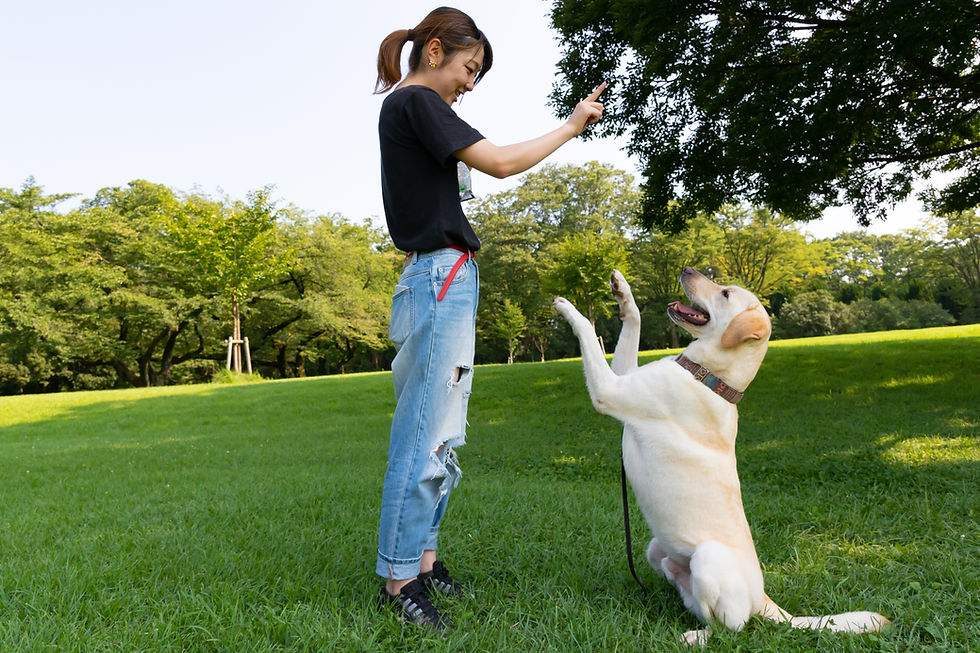Fun in the Summer Heat
- Joylynn

- Jul 1, 2022
- 4 min read

Is this your puppy’s first time seeing tall blades of grass with morning dew as the birds sing hello for the summer sunrise? Exciting isn’t it?! Watching them play and explore new sights, smells, and adventures. Their world is spontaneous and captivating as bugs are constantly a distraction on walkies and each new smell needs at least a few more seconds. Other new experiences for them are high temps and the heat index. To help your puppy this summer there are specific signs that we can look for to know if they have been in the heat for too long and may be at risk of danger that is easily over looked. Heat stroke can be prevented by taking proper care and reading the warning signs that our dogs give us. Let’s make sure puppy has the best new experience possible this summer!!
Prevention
Along with plenty of cool water, the most important thing to do to keep a dog cool is stay
indoors or in the shade during hot parts of the day. Before going outside to play for the
day take a few things to keep puppy cool. Hand held power fans store easily in bags or
coolers, a cooling pad or a cold, wet towel that you can spread out for your dog to lie on.
You can also have him stand on a damp towel to help the footpads release heat. A
spray bottle filled with cool water to spray his underside that’s not exposed to the hot
sun (such as the groin area, where the hair is less dense), the bottoms of his feet, and
inside his mouth. Keeping your puppy cool, hydrated, and in the shade while playing
outdoors is our responsibility as their trusted companion.
Dogs lose heat through the pads of their feet and by panting. To help condition your
dog’s paws, walk on the pavement during cool weather. The hard surface helps toughen
them and builds resistance for when the temperature heats up. If you must take your
dog out during hot weather, avoid the hottest time of day. Walk in the early morning or
evening. Choose grassy or shady areas. To find out if the ground is too hot for your dog
to walk on by placing your hand comfortably on the pavement for 10 seconds. If it’s too
hot for your hand, it’s too hot for your dog’s paws.
For exercise during hot weather, set up a hard, plastic outdoor wading pool made for
dogs. Plastic children’s pools tempt dogs to dig and tear. If your dog swims in an adult
pool, add a canine life vest for safety.
Knowing the Signs
Heat stroke occurs when a dog’s body temperature rises and he overheats, and if left
untreated for too long it can be fatal. Every dog owner should be aware of the signs of
heat stress and heat stroke.
Unusual breathing (rapid and loud).
High rectal temperature (103 or higher).
Extreme thirst.
Weakness and/or fatigue.
Frequent vomiting.
Disorientation.
Dark or bright red tongue and gums.
Skin around the muzzle or neck doesn’t snap back when pinched (dehydration).
Difficulty breathing.
Thick saliva.
Rapid heartbeat.
Heavy drooling.
Agitation.
As a dog’s temperature rises, blood rushes to the surfaces of the tongue, gums, and
membranes to help transfer excess heat. Frantic panting, extreme salivation, bright-red
membranes, and labored breathing are clear warning signs that your dog is overheated
and may quickly progress to a metabolic meltdown as his temperature rises to over 106F and he can no longer cool himself. Even if you can cool him and he acts normal, rush
him to an emergency clinic because his organs may have already been damaged.
What to do
Calmly contact your veterinarian or emergency animal services.
Walking or carrying the dog to a well ventilated, cool area.
Spraying or sponging the dog with cool (not cold) or tepid water especially on the
underside. Do not immerse the animal in cold water.
Using a fan to blow cool air on him.
Severely affected dogs require fluids, medication, support, and oxygen. Complications
may not occur immediately, so it’s important to let your veterinarian determine the type
of follow-up treatment required.
What about the Car?
Never leave your dog unattended in a car, even for a few minutes, as temperatures
inside a vehicle can quickly climb to dangerous levels. The inside of a vehicle parked in
70-degree weather can reach 100 degrees in just 20 minutes. On very hot days,
temperatures inside parked cars can climb to 140 degrees Fahrenheit in less than one
hour. The issue is so important that 28 states have laws restricting people from leaving
their pets unattended in vehicles. Some laws ban the practice outright, while others
protect law enforcement officers and citizens if they break into cars to rescue pets.
If you know you’ll be on the road with your dog, make plans. Take a spare set of keys
so the car can be running at all times with the doors locked when you are out of the car.
Have a riding companion so that your dog is never left alone unattended. Have frequent
stops mapped out as part of the destination.
Treats to Beat the heat
For an ice cream alternative with the same texture and consistency as the real thing, try
blending frozen fruit with plain, unsweetened yogurt. Watermelon is safe for
dogs. Cantaloupe chunks are another excellent option. Be sure to remove the rind and
seeds from either melon, and always feed sweet fruit treats in moderation, taking the
calories they provide into account with your dog’s regular diet.
As you and puppy explore new adventures this summer start each outing by being
prepared, knowing the signs of heat stress and staying cool!!



Comments